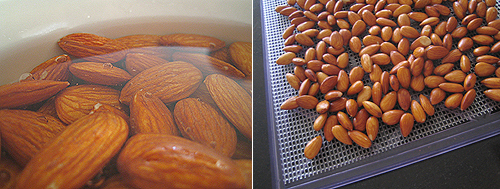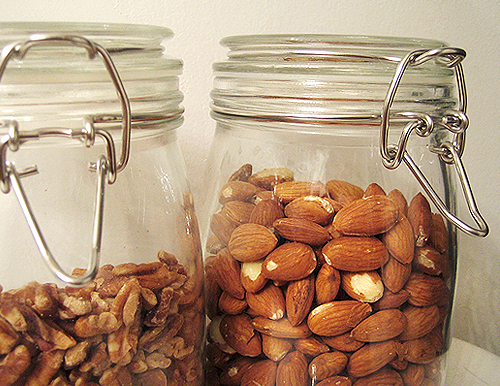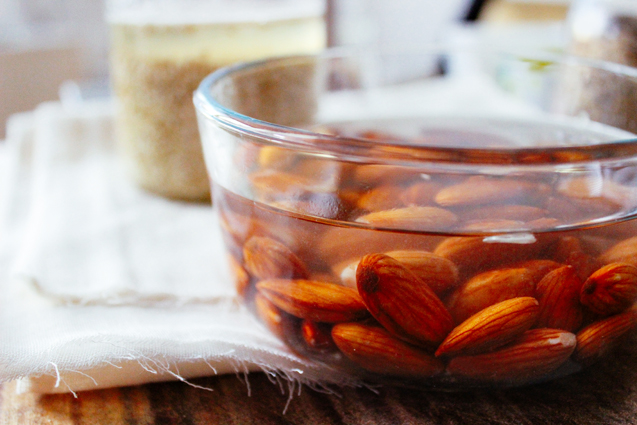Nuts, seeds and legumes are packed with healthy fats, protein and minerals, but to get that all good stuff assimilated into your body, it is recommended that you prepare them by soaking them. See, nuts, legumes and seeds contain “anti-nutrients” like phytic acids and enzyme inhibitors to keep them from sprouting until nature delivers the sun and rain that they need to grow. Have you heard people, maybe even yourself, say “nuts or beans are hard on my stomach”? Well, enzyme inhibitors/phytic acids are the reason. By soaking, enzyme inhibitors are neutralized, the beneficial enzymes are activated and the vitamin content increases. Soaking makes seeds, nuts and legumes easier to digest and the nutrients more easily absorbed. Think about it like this, snakes have fangs, porcupines have quills, and plants have anti-nutrients to protect themselves.
Health food stores are starting to stock pre-soaked/sprouted legumes, grains, nuts and seeds, so look for these if you are pressed for time or don’t have a dehydrator.
I discuss using a dehydrator here so you can have ingredients prepared and ready, since a plant-powerful diet is all about accountability and planning.
YumUniverse recipes will usually always call for soaked nuts, seeds, grains and legumes. The only exceptions, are when I call for toasting (which neutralizes some of the enzyme inhibitors) which is a step I recommend for flavor/texture purposes, or if the ingredients do not need to be soaked due to lack of, or very minimal, enzyme inhibitors. Soaking and then dehydrating will ensure that you have prepared ingredients on-hand. I usually take one day a week and prepare all of my ingredients—it’s usually shopping day, or the day after. You can skip soaking, but if you experience gas, bloating or swelling, don’t say I didn’t warn YU.
I also call for soaking for texture purposes for particular recipes. For example, chia seeds becomes like egg white when soaked. Chia is a great substitute for eggs when baking. This unique thickening property also makes a scrumptious gelatin-free pudding.
Cashews, sunflower seeds and other nuts will soften when soaked, which makes them easier to blend into creamy non-dairy sauces and non-dairy milks.
What’s the difference between soaking and sprouting?
YU may have read online all about “soaking” and “sprouting” and your brain is about to melt. Both are extremely beneficial from a nutritional standpoint. (https://vallartainfo.com/) Let’s clarify the difference between the terms. Soaking is the first step you take when you are going to sprout nuts, seeds, grains and legumes. When sprouting, you continue on past the soaking step, with an easier-than-YU-think-process over the course of a few days, to actually encourage sprouting of your nuts, seeds, grains or legumes.
Learn all about sprouting here and here.
– – –
Want to try out some recipes that use soaked ingredients?
Tools
Dehydrator (optional)
Baking sheet (optional)
Unbleached parchment paper (optional)
Make sure to buy organic ingredients whenever possible. Here’s why.
Recommended Soaking Times
Make sure all nuts are raw before you begin.
plant-based
Almonds*: 8-12 hours
– – –
Cashews*: 2 hours
– – –
Buckwheat: 6-8 hours
– – –
Hazelnuts: 6-8 hours
– – –
Macadamia Nuts: The verdict is out on this one, some say soak, some say don’t. I sometimes choose to soak them for 2-4 hours, but usually skip it.
– – –
Pecans: 6-8 hours
– – –
Pine Nuts: 6-8 hours
– – –
Pumpkin Seeds (a.k.a. Pepitas): 6-8 hours
– – –
Sesame Seeds: The verdict is out on this one too, some say soak, some say don’t. I usually toast them for flavor, but if you choose to soak, 4-6 hours should do. Have a tightly woven strainer available or a cheesecloth to strain without losing your seeds down the drain.
– – –
Sunflower Seeds: 6-8 hours
– – –
Walnuts: 6-8 hours
– – –
Lentils: 8-12 hours
– – –
Green Peas: 12 hours
– – –
Chickpeas/Garbanzo Beans: 12 hours
– – –
Quinoa: 6-8 hours
– – –
Click here to learn more about Soaking and Cooking Legumes
Click here for the Ultimate Non-Dairy Milk Guide
Do not soak
Flax Seeds: become mucilaginous when mixed with water, and are often used as an egg replacer in vegan baking recipes, but flax is very sensitive to heat. The EFAs (essential fatty acids) in flax seed can break down and become toxic when heated, so I personally only use flax in smoothies and cool/cold recipes like salads (low temp dehydrated recipes should be ok). You also need to grind up flax seed (coffee grinder) to assimilate the nutrients—their husk will make them pass right on through your system undigested. Always store flax seed in the fridge or freezer to keep the delicate omegas intact. I use soaked chia seed for baking, because it can stand up to heat, has similar nutritional benefits and the same egg-white like properties.
– – –
Hulled Hemp Seeds: note that these are also sensitive to heat and light, like flax seeds. Best used in salads, smoothies and other cooler temp recipes (low temp dehydrated recipes should be ok).
– – –
Recommended Dehydrating Times
Make sure that you fully dehydrate your ingredients so no moisture is left. You don’t want them to mold, you want them tasty and crunchy. 12-24 hours for all nuts, seeds. legumes and grains. Just taste them every 6hrs to see if they are dry and crunchy enough.
You Can Dry Nuts/Seeds in the Oven
Now, they won’t be considered “raw” because the temp will exceed 115° F (and some enzymes will be lost), but you will still get many benefits from oven dried nuts—and if you dry them long enough, they will toast a bit, which always adds great flavor to recipes. Set your oven to the lowest temperature possible. Dry nuts for 30 minutes to 1 hour on a parchment-lined cookie sheet. Remove a nut/seed, cool it and taste. Is it crunchy? Or a bit soft on the middle? If still soft, put back in the oven and repeat this step (checking on nuts/seeds every 20 minutes) until they seem dry. Store in the fridge.
Use this technique for the following:
Almonds
Cashews
Buckwheat
Hazelnuts
Pecans
Pine Nuts
Pumpkin Seeds
Sesame Seeds
Sunflower Seeds
Walnuts
Do not use this technique for:
Hemp Seed
Flax Seed
Macadamia Nuts
This technique also works for preparing pantry storage items like:
Lentils
Peas
Garbanzo Beans
Quinoa
YU can use already soaked and dehydrated nuts and seeds from storage for recipes that call for soaking.
For grains and legumes, YU can (and will) cook your dehydrated ingredients according to a particular recipe’s instructions.
Let’s soak.
First, if a recipe calls for soaked nuts/seeds/grains/legumes, measure them post-soaking.
Dry nuts usually yield about 1/4 cup to 1/2 cup more when soaked.
To soak nuts, seeds, legumes and grains, dissolve 1 tsp sea salt in a bowl of 2-3 cups of pure, warm water. Add your ingredients. Make sure there is enough water to cover them about 2 inches. Follow the guidelines above for soaking times. Once soaking time is reached. Toss the soak water (don’t consume this, it contains the enzyme inhibitors that YU are trying to get rid of) and rinse your ingredients well.
Sally Fallon (founding president of the Weston A. Price Foundation) explains that using salt to soak nuts “…helps activate enzymes that de-activate the enzyme inhibitors. For grains, we soak in an acidic solution to get rid of phytic acid. Nuts do not contain much phytic acid but do contain high levels of enzyme inhibitors. The method imitates the way the native peoples in Central America treated their nuts and seeds–by soaking them in seawater and then dehydrating them.”
Soaking seeds and nuts is easy and you don’t need a dehydrator to prepare your nuts for easy digestion. You can store soaked nuts in your refrigerator for 5-7 days until you eat them or use them in a recipe.
To stock your pantry with soaked ingredients, however, you will need to dehydrate them. This requires a dehydrator, which can be purchased online.

Dehydrate ingredients at a temperature of 95-100°F to maintain beneficial enzymes that enhance digestion and assimilation. I recommend the Excalibur—it’s what I have in my kitchen and I don’t want to imagine life without it. A dehydrator is a key appliance for a raw, vegan and/or health-conscious kitchen. You can make endless treats in a dehydrator like Raw Citrus Spice Cashews for topping salads or eaten alone as snacks, fruit leather, Raw Sweet Potato Chips, even desserts like Raw Cacao Tartlets.
Make your life easier. Soak ingredients in large batches when you return from shopping trips, then dehydrate them and store them in airtight glass jars for when you need them. To maximize space, I use stackable glass jars. Keep your pantry stocked and ready.

Always in our pantry soaked and dehydrated:
Almonds, pecans, pumpkin seeds, sunflower seeds and walnuts.
These seem to be the go-to nuts.
– – –
*Sadly, U.S.-grown raw almonds are no longer available commercially. Since 2007, all U.S. almonds must be “pasteurized,” meaning fumigated with chemicals—or steamed, if organic. Most times, cashews labeled raw, are unfortunately not since they undergo two separate heatings at harvest. To get truly raw almonds and cashews with all their enzymes and vitamins intact, you must get them directly from the farmer or suppliers like Vivapura.
– – –
References:
1. Smallfootprintfamily.com
2. Sally Fallon, westonaprice.org
3. TheNourishingGourmet.com
Visit us at our new home: Good Food Cooking School




A question about the temperature of drying the nuts. I was under the impression that heating them destroyed the enzymes. Does the heat that you have the dryer or oven heated to not do this?
Thank you
Liora~
You are correct in that heating foods above certain temperatures destroys the life of the food. There are many reports on ideal drying/dehydrating temps to maintain beneficial enzymes and nutrients. I’ve seen temps ranging from 90°F to 145°F as safe. I like to stick around 95°F-100°F when preparing raw foods and for this I use a dehydrator. Personally, I still eat baked foods (prepared at higher temps), knowing that the digestive enzymes are compromised. To help my digestive system, I tend to take a lot of digestive enzyme capsules or eat fermented foods (like homemade kimchi) before I consume cooked foods. Hope that helps!
I note that for soaking grains, Sally Fallon recommends using an acidic solution. What type of solution will work for this? lemon juice? or…?
A simple pinch of sea salt sprinkled into the water will do.
I just found your site today, and it looks like it’s full of great information. I look forward to exploring it.
I read your posts about dehydrating sprouted legumes, but I’m still a little unclear about how to go about this. I’ve experimented with dehydrating sprouted legumes in my oven with mixed success; the lowest setting on my oven is 170 degrees. And a concern I have is to make sure that they are full dehydrated before I store them so that they don’t mold.
I would appreciate any help you could give me or any resources you could direct me to.
Thanks so much!
Kathy
Hi there Kathy, …
…
Great questions and you are absolutely right about wanting to get them 100% dried out before storing—water brings mold. I talk about using the oven only for “drying” nuts and seeds in the post because I think the temperature is just too much for the softness of a legume. I’ve only had success drying nuts and seeds in the oven (and seeds/pseudo-grains like buckwheat), but even those are times where I’m in a hurry. When I am storing sprouted legumes, nuts and seeds for the long haul, I always use the dehydrator. The dehydrator temperature will go as low as 90F, which is what you need to maintain all the beneficial enzymes and nutritional oomph that sprouts contain. Any temps over 110-115F will diminish nutrient vitality of any sprouted/live foods. Hope that helps. There are some reasonably priced, small 4-tray dehydrators out there. Just ask The Google. I love my Excalibur
Great information! Thank you so much. Once the nuts are dehydrated, how long will they last in the pantry or the fridge?
Christianne,
Once totally dry they can last in the fridge or pantry for 6-12 months just fine. It’s super important that ALL moisture is out of the soaked ingredients though. Moisture = mold which speeds up perishability. Have fun!
Hi, this article was very useful. I soaked my nuts and then put them away without them fully drying. they started to produce this cotton like mold. Should I throw them all out or can I resoak them?
Sounds like the moisture attracted some mold, Selen. You’ll need to start over 🙁 Make sure they are bone-dry next time and you should be good to go. x H
Thank you for the info. After they are dehydrated, when a recipe calls for soaked nuts, do you need to soak them again? If so, is it a shorter amount of time?
Hi Lisa,
Great question. It depends on the recipe—if the nuts are being blended into a sauce of some kind, you’ll want to rehydrate them by soaking. It will help them break down into a smooth, creamy texture if they are soaked. If the recipe is ultimately using them dry, no need to soak again! H